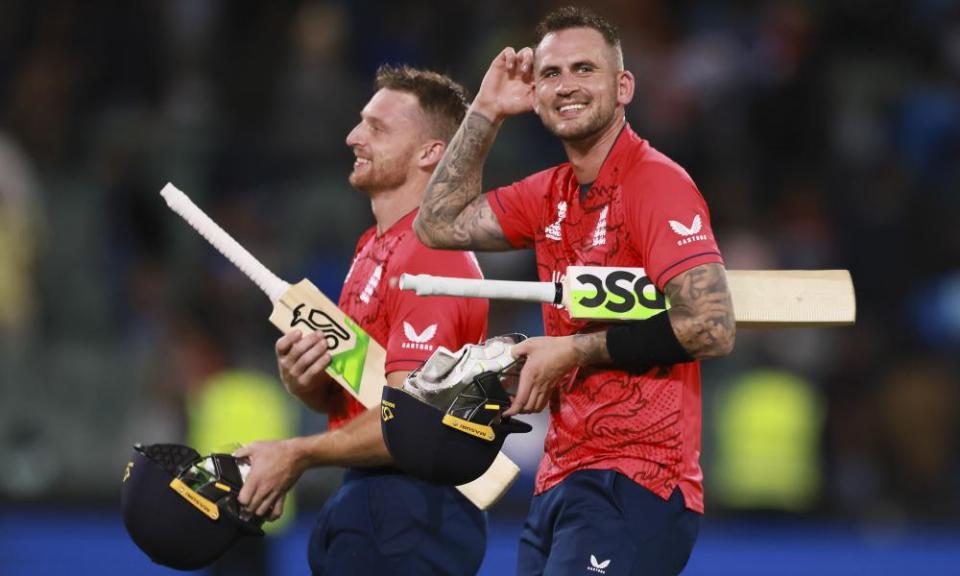England thrash sorry India to set up T20 World Cup final against Pakistan
England somersaulted and cartwheeled their way to a stunning and historic thrashing of India in Adelaide to rocket into the T20 World Cup final, as Alex Hales and Jos Buttler took on the world’s best-supported and most lavishly resourced side and toyed with them like a cat might a ball of wool, making them look approximately as threatening.
Pakistan await in Melbourne on Sunday, and will not have enjoyed what they saw of their opponents here. England reached 170 with all 10 wickets and four overs to spare, Hales (who scored 86 off 47) and Buttler (80 off 49) producing not just the largest but in any sense you like the greatest opening partnership in England’s Twenty20 history. By the end India were a rabble, their performance summed up by England completing an all-run four, vanishingly rare in this format, after Mohammed Shami fielded and tried to toss the ball to a teammate but missed, and by Suryakumar Yadav racing back from mid-off and not only failing to catch Buttler but managing instead to shovel the ball a further 10 yards to the rope.
Related: World domination eludes India again in World T20 despite abundant riches | Geoff Lemon
Poor Phil Salt, scheduled to come in at No 3 but not required. Having watched every game so far from the sidelines he was chosen to replace Dawid Malan, but still had to watch most of the game from the sidelines. It is impossible now to dispute England’s decision to favour Hales as opener, and since they reached a position of having to win every remaining match he has scored 52, 47 and now 86 at an average strike rate of 158. This was a remarkably controlled innings, in which he scored at great pace but appeared in no hurry, and his best shots were not only stylish in their execution but impeccable in their timing. India for example would have hoped to use their spinners to control England’s run rate but twice, against Axar Patel and Ravichandran Ashwin, Hales disabused them of that idea by sending a slog-sweep into the crowd.
Buttler meanwhile had promised to show no fear of Bhuvneshwar Kumar, against whom he previously had a notably poor record. He scored 13 runs off the seven balls he faced from the 32-year-old, cracking three fours off the bowler’s first over, and after his second ended with Hales dancing down the wicket to hit over long-off for six Kumar was sent to field on the boundary, never to return. Once the finish line hoved into view Buttler sprinted for it; after scoring 45 off his first 34 deliveries, he added 35 off his last 15, including the six that ended it.
The ground that witnessed England’s worst moment in white-ball cricket, against Bangladesh in 2015, thus witnessed what stands perhaps just the 2019 World Cup final away from their finest. This was a night when a side that had not really reached top gear at any stage in this tournament suddenly went supersonic.
Though Virat Kohli scored another half-century it was Hardik Pandya, with a 33-ball 63, who was most responsible for hauling India to what appeared a reasonable total with a string of boundaries towards the end of their innings – and there would have been one more had he not stepped into the stumps while powering the last ball towards the rope. But rather than striking terror into England, his innings inspired only hope – Buttler said afterwards that Pandya had just “showed what a good wicket it was”.

Pandya’s innings at least turned an outright humiliation into a mere emphatic thrashing. For much of their 20 overs India were simply pedestrian, becalmed both by some excellent bowling – Adil Rashid was outstanding, going at five an over and taking the key wicket of Yadav, and Chris Jordan replaced the injured Mark Wood and took three wickets in his first game of the tournament – and some puzzling lack of ambition with the bat.
England’s three previous run chases in the competition, against Afghanistan, Ireland and Sri Lanka, were all uncomfortable but this was a team transformed. They took a quite different approach to their innings to India, in that they tried to score quite quickly at the beginning of it. They still had 10 balls of the powerplay remaining when they matched six-over India’s total; they reached 50 off their 29th ball, when it had taken India 43. Halfway through their innings India had scored 62 off 60 balls; England were on 98.
It was a spectacular vindication of Buttler’s decision at the toss to chase, which while his instinct most of the time was not in keeping with the fresh consensus that has settled over this tournament. It seemed to be this consensus that informed India’s innings – only one team here, and none at all in the Super 12s, had successfully chased more than 160, therefore 168 would be an excellent score. England on the other hand had been positively salivating over the state of the wicket for three days and thought there might be more runs in it. Turned out they were right.

